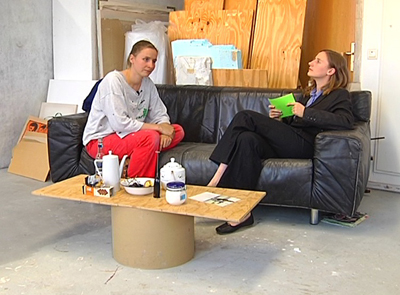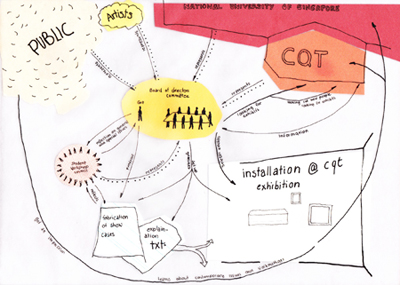Highlights
CQT welcomes artist-in-residence

CQT is pleased to welcome artist Grit Ruhland for a one-month residency. From 26 March to 20 April, Grit will be working at CQT on a "Cabinet of Curiosities". She will be offering talks, workshops and inviting researchers, students and Singapore-based artists to participate in the project. A Board of Directors will help to collect, select and tag artefacts from CQT for inclusion in the Cabinet.
Please see below for Grit's description of her project and dates of the associated events. Please note that participation in the workshops and board requires pre-registration and places are limited: email artscience.residency@gmail.com to book a spot.
Grit, pictured right (twice), is an artist based in Dresden, Germany. Her residency at CQT is arranged through the 2012 NUS ArtScience Residency scheme, organised by the Arts & Creativity Lab of the Interactive & Digital Media Institute (IDMI) and supported by the National Arts Council, University Scholars Program, University Town and selected NUS research centres. CQT, which last year supported two artists developing a physics-inspired installation, is one of four research centres that will host an artist through the NUS scheme in 2012. You can follow the artists' projects on the Art/Science Residency programme blog and Facebook page.
Grit has previous experience of arts/science collaborations, having spent a year as artist-in-residence at the Max Planck Institute for Cell Biology and Genetics in Dresden. She is looking forward to her immersion in quantum physics. Look out for her artwork appearing on CQT's level 3 and level 6.
Grit's project at CQT, in her words
"Cabinet of Curiosities" is looking for you! Welcome to the starting point of an open, temporary, collaborative experiment that reunites art, craft and science itself within the Center of Quantum Technologies. Surprising discoveries, funny errors, unexpected correlations, astonishing or symmetric numbers, pictures of the day - things like that, are possible future components. Within this invented institution, items, stories, photos, notes and numbers — related to the daily work in the Center of Quantum Technologies — will be reflected, tagged and collected. A 'board of directors' will discuss and decide what shall be part of the collection. The board will consist of interested students, scientists and artists. A series of actions will accompany the whole project.
How artist Grit Ruhland hopes to engage CQT and NUS researchers and students, Singapore artists and the public during her one-month art-science residency at CQT. Click the image to see a larger version.
Students are welcome to see a two-parted workshops to introduce, learn and discuss about artistic and philosophic questions. We will discuss and develop ideas, what could be a contemporary curiosities within the field of quantum physics. We will speak and learn about the interpretation, sense and non-sense of technical images, aesthetic qualities formulas, the relation of creation and representation and other artistic and philosophic issues. Interested students can make their own impact in this conceptual artwork.
What is it about?
The idea has its inspiration in a European entity started in the 14th century — the rarity- or curio-gallery. It arose in a time, that can be considered as 'era of astonishment'. The renaissance was an age where art and science developed together, made milestones and still were not yet divided in the extent of today. The collections contained both natural products and artefacts. Additionally, they were not separated into science, art and crafts. Selected objects had been presented in fancy show cases, similar to cupboards and furniture. The whole installation had been seen as Theatrum mundi, a general view on the whole world and its human understanding. How can we use and transform this archetype into a contemporary art-form? Is it possible to find an interesting aesthetic approach to a rather abstract and invisible knowledge?
Calendar of events
If the calendar of events is not displaying, click here to view it.







